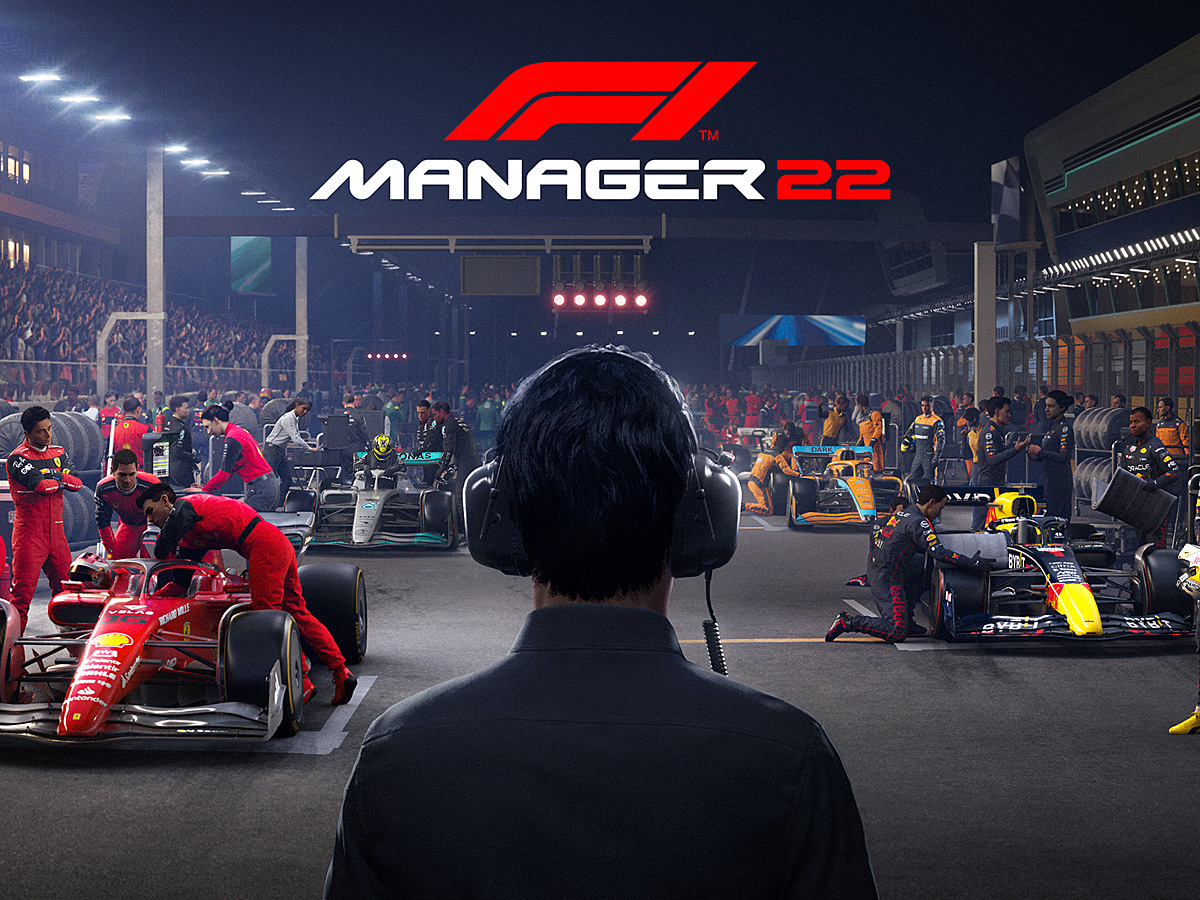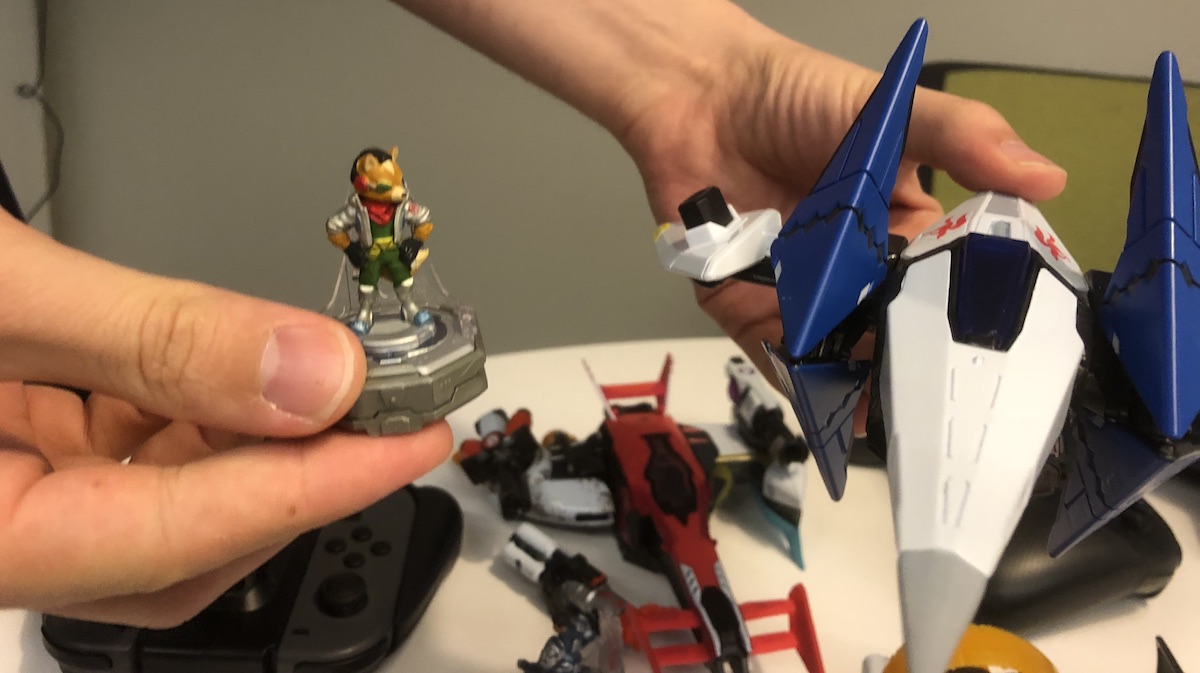What Is F1 Manager 2022?
F1 Manager 2022 is a management simulation game in which you’ll play as the Team Principal for one of the 10 teams competing in the 2022 Formula One season.
Age Rating
F1 Manager 2022 is rated PEGI 3 and ESRB E/Everybody. That being said, although there is no objectionable content to be found here, the game is incredibly complex and requires vast amounts of reading, so it is unsuitable for young children.
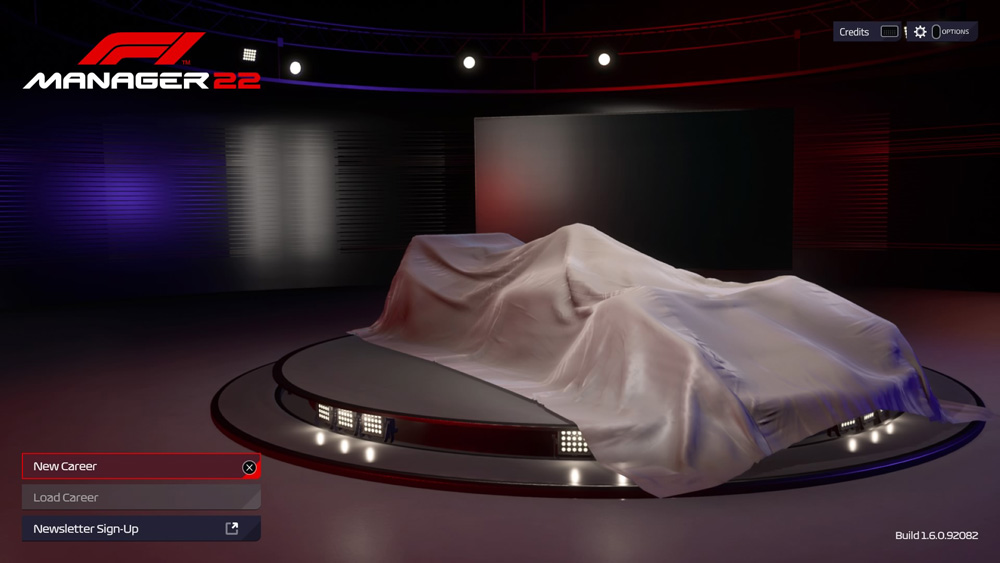
Available Formats
F1 Manager 2022 is available on:
- XBox One
- XBox Series X|S
- PS4
- PS5
- PC via Steam or Epic Games Store
System Specifications
MINIMUM:
Requires a 64-bit processor and operating system
OS: Windows 10 64-bit
Processor: Intel Core i5-4590 or AMD FX-8370
Memory: 8 GB RAM
Graphics: Nvidia GeForce GTX 960 or AMD R9 280x (3GB VRAM)
Storage: 30 GB available space
RECOMMENDED:
Requires a 64-bit processor and operating system
OS: Windows 10, 11 64-bit
Processor: Intel Core i7-7700 or AMD Ryzen 7 2700
Memory: 16 GB RAM
Graphics: GeForce GTX 1080 or Radeon RX 580 (4GB VRAM)
Storage: 30 GB available space
F1 Manager 2022 Trailer
F1 Manager 2022 Gameplay
Before I begin, I want to make one important point. F1 Manager 2022 is a racing team management game, NOT a racing game. At no point will you yourself control the cars or drive in a race, this is purely management and strategy, not racing.
F1 Manager 2022 has one game mode: Career. In it, you’ll select your team and play through the complete 2022 season, warts and all. Although there is only one game mode, there is so much packed into that mode that you won’t even notice.
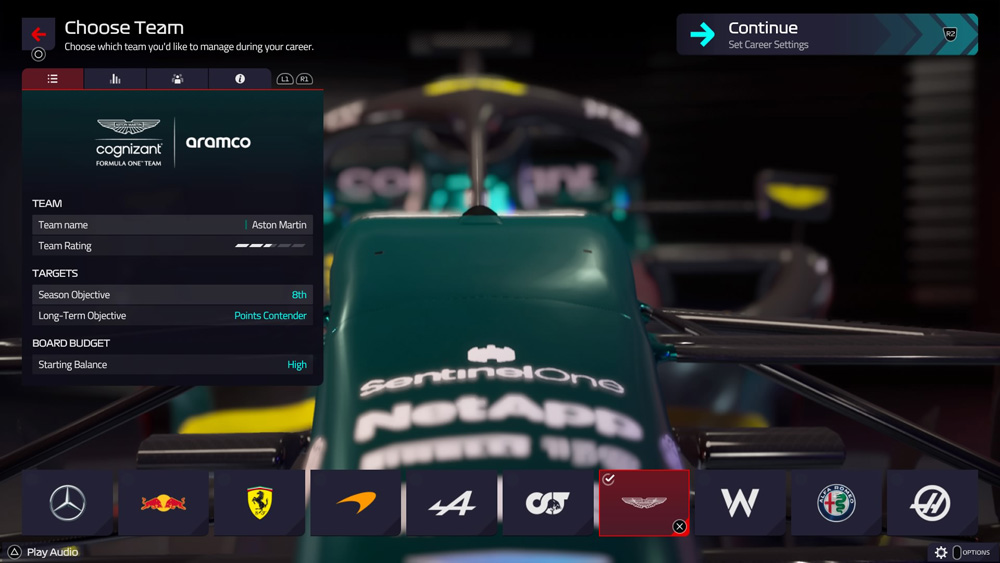
The first thing you’ll do on loading up a new game is to choose your team. All the teams from 2022 are present with their respective drivers, but there is more to choosing than simply picking the driver or team you like best. Each team has different goals for the new season. Higher-ranking teams have bigger budgets and are aiming for podium positions, while those at the back of the pack will be aiming to make it through qualifying and work their way up the ranks. It has been suggested that for your first career, choosing a high-ranking team may make things easier, something I wish I’d read before deciding to embark upon a career with the second lowest-ranked team, thinking it would be a bit easier due to less pressure to win!
Once you’ve chosen, you’ll get into the core of the game with the Home Screen. This is packed full of information from the board’s confidence level in you (don’t let it fall too low or you’ll find yourself replaced), the performance of your drivers in the previous race, and a calendar of upcoming events. Along the bottom of the Home Screen are 12 tabs that will take you to the rest of your dashboard where you can make decisions. I’ll go through the other 11 of those now.
Gameplay Screens
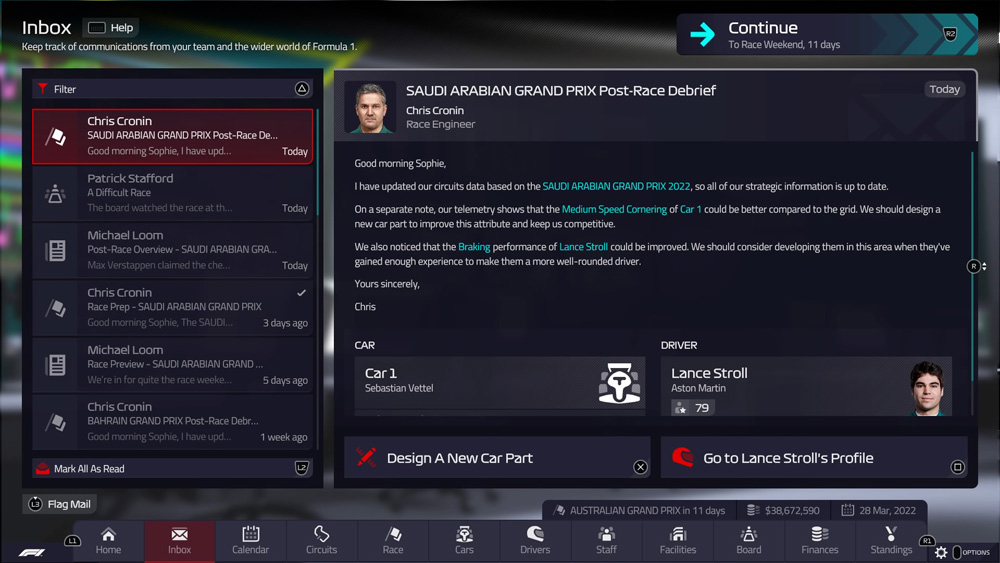
Inbox: An obvious and relatively simple screen, this is where you’ll receive messages from anyone and everyone connected to your team. As a sample, immediately following my first race of the season I received a Post-Race Debrief from my Race Engineer that pointed out where my cars could be improved, a message from a Board Representative expressing their disappointment at the team performing below expectation, an overview of the previous race from a reporter, an announcement from my Technical Chief that a new suspension system was now available, and a message from a Talent Scout about an up-and-coming new driver I should keep an eye on. It’s a lot to keep track of, but the game will alert you to any emails of particular significance.

Calendar: Another fairly obvious screen, here you can look through the upcoming events for you and the team from month to month. You’ll see everything from the races themselves along with practice and qualifying sessions to sponsorship events, and estimated completion dates for manufacturing and research projects. This can help you get an idea of what’s coming up, and whether new parts are likely to be ready in time for the next race.

Circuits: Here you can look into all the circuits in the current season. There’s basic information to be found such as the length of the track and overall race distance, speed records, and weather predictions, but also more useful information such as the car attributes most useful at each circuit, expected race strategies based on current weather predictions, and the predicted performance of each type of tire compound.

Race: One of the most important screens, here you’ll see everything related to the next race of the season. You’ll see some of the same information from the Circuits screen but also your specific performance targets as set by sponsors with the potential rewards associated with them. Locking in targets offers greater rewards, but also risks penalties if those targets are not met.

Cars: Another vitally important screen, here you’ll manage the cars themselves. This screen covers everything from the build of each car to the analysis of its performance. You can also check in on the design and manufacture of new parts. Each team has two cars and each car is made up of nine separate parts with its performance then determined by 12 attributes dictated by those parts. The attributes needed will also differ between circuits. You’ll need to design parts and then manufacture and install them. Here is also where you can research new parts for the next season to get ahead of changes in regulations. Unused parts are stored in the Warehouse.
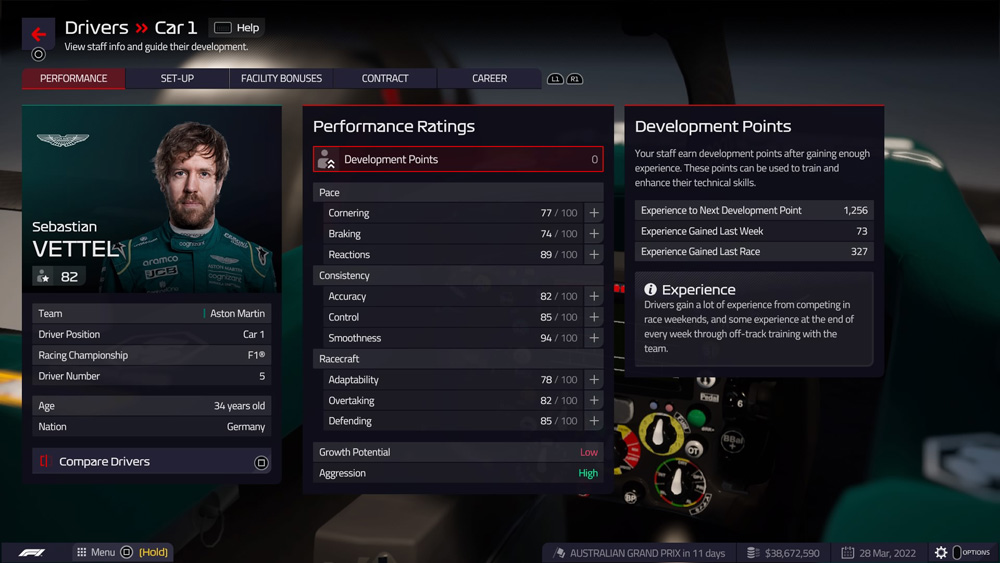
Drivers: On this screen, you’ll manage your team’s driver lineup. You’ll have two active drivers, one in each car, as well as a reserve driver. Here you can check on each driver’s morale and remaining contract length, as well as see basic stats such as their age and nationality. Each driver also has an overall rating and can earn development points through experience. These points can be used to train and enhance technical skills. This screen is also where you’ll scout for new talent and potentially look to replace drivers.

Staff: This screen is broadly similar to the Drivers screen but here you’ll manage everyone who works behind the scenes. You have four Key staff members: the Technical Chief, the Head of Aerodynamics, and two Race Engineers. As with the drivers, you’ll see morale, contract length information, overall rating, and development points. Additionally, you’ll also manage an Engineering Team, Scouting Team, and Pit Crew. You can adjust the size of the teams and their monthly salary for the Engineers and Scouts, while for the Pit Crew you can adjust their training focus and the monthly salary of the crew.
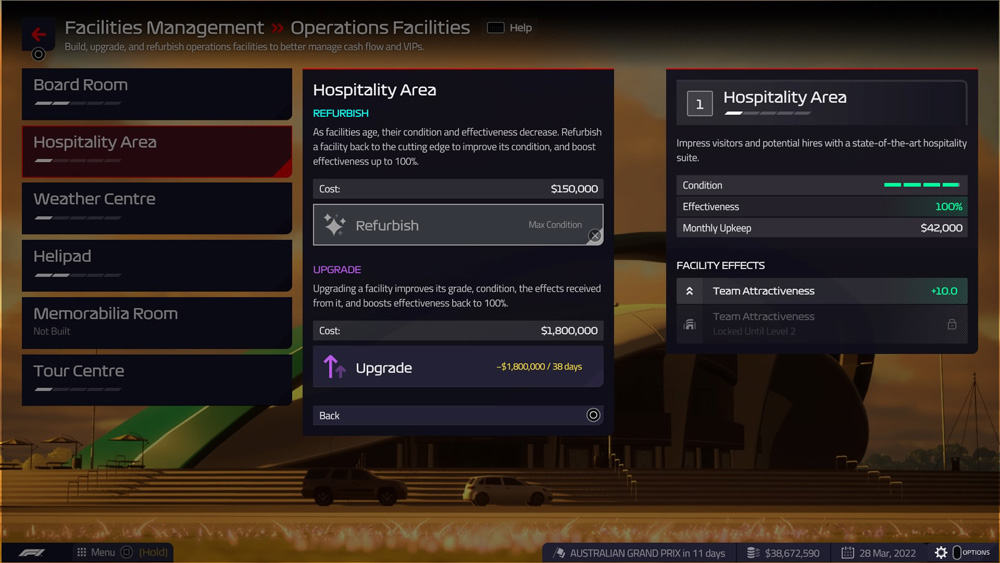
Facilities: Here is where you’ll manage the team’s buildings. There are Car Development facilities (the factory, wind tunnel, suspension simulator, etc), Staff Facilities (the team hub, scouting department, etc), and Operations Facilities (board room, weather center, helipad, etc). Each of these can be individually upgraded or refurbished to help with board confidence, overall team attractiveness to sponsors, team morale, and more.

Board: Here’s where you’ll get some insight into how the team’s owners think you’re doing. You can check the board’s confidence in you and the season objectives they have set, the season budget (both overall and monthly), the team’s rating, and your personal statistics. Here you can also read summaries of the various technical regulations that will govern your car design choices.

Finances: A vital part of any management game, here you can check in on your balance (with breakdowns and predicted spending to the end of the season based on current settings), look over your monthly recurring income and outgoings, keep an eye on how close you’re getting to the season spending cap, and manage your team’s sponsorships.

Standings: Finally, there are the standings. On this screen, you can see the current positions of both the Constructors and Drivers championships. It’s probably the most familiar part of the game to anyone who has ever watched a Formula One race.
You can scroll between all these tabs at any almost point and there is no clock determining how long you can stay there, but Race Weekends are when all your best-laid plans built across all these areas are put into motion.
Race Weekends
As in the real world, Race Weekends take place over three sessions: Practice Sessions 1 and 2 on Friday, Practice 3 and Qualifying on Saturday, and the Race itself on Sunday. At any point, you can choose to jump ahead to the next Race Weekend and get started. At the beginning of each Race Weekend, you’ll need to have checked the circuit info to plan a strategy, read any performance targets set by sponsors, and ensure that your cars are using the best parts available. Don’t worry, you’ll get an email reminder before it all begins.
Practice Sessions
During Practice, you’ll have the option to either manage each session yourself or let your staff do so for you. There are three Practice sessions before each race and you can choose to individually manage all three, individually manage just the ones you want, or let your staff handle everything through to Qualifying. If you individually manage the sessions, you’ll choose when to send out each car and watch real-time footage of the session while listening to occasional radio telemetry between the crew and drivers. Practice Sessions last for an hour each and, yes, that’s in real-time, although you do have the option to speed time up to 16x. It’s tempting to skip a lot of these sessions (because honestly, even the most die-hard of fans is likely to get a little bored watching simulated cars endlessly lapping for an hour), but running through the sessions manually does have a positive impact on your drivers, so that’s a trade-off you’ll need to think about.
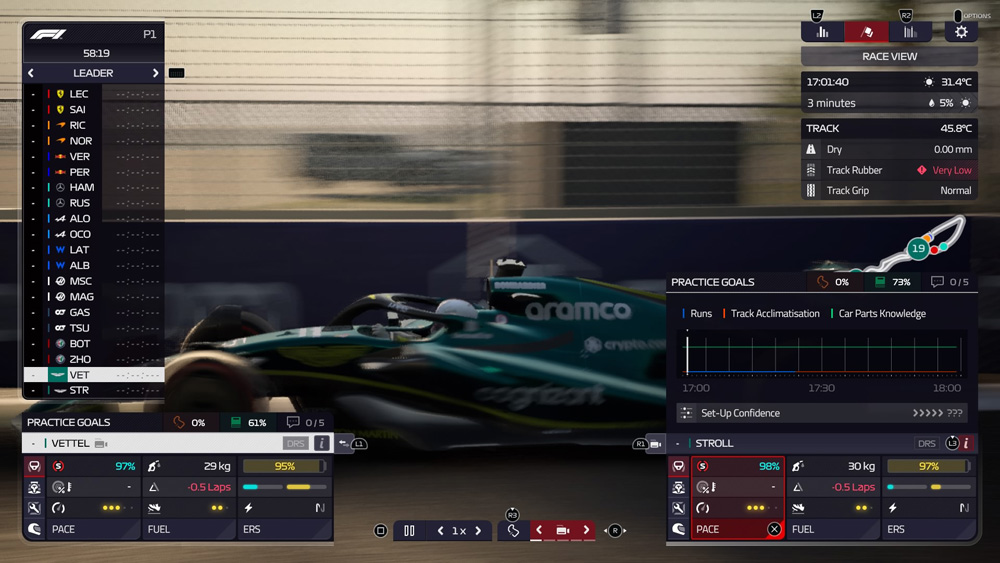
Throughout the sessions, you’ll manage when to send cars out or bring them into the pits, keep an eye on the car’s condition, and set the pace from Conserve through Light, Standard, Aggressive, and Attack, each of those increasingly more demanding. You’ll also manage the fuel and ERS. Bare in mind that with two cars, you’ll need to be doing this for both of the cars/drivers simultaneously too.
One thing I couldn’t find is a way to exit a Practice Session partway through and let the simulation take over from there, so if you choose to manage it yourself, you’re stuck until the end!
Qualifying
Once you have completed all three Practice Sessions, it’s time for Qualifying, which is itself made up of three sessions, although each one is far shorter so this is all managed in one group. During each session you’ll need to decide when to send the cars out, ensuring you have enough time to set a lap time and trying to avoid getting snagged in traffic which will impact your fastest times. Q1 lasts for 18 minutes, Q2 for 15 minutes, and Q3 for 12 minutes—although cars out on track who have passed the chequered flag can set one more flying lap after that time expires so in reality, it will last slightly longer. You’ll need to qualify (hence the name) for sessions two and three by recording a fast enough time to do so. Of the 20 cars participating in Q1 you’ll need to place in the top 15 to gain a place in Q2, and of the 15 cars in Q2, only the top 10 will reach Q3—if you don’t qualify, the remaining sessions will take place automatically. If you’re playing as one of the lower-ranked teams, there’s a high chance you’ll only be managing the first of the three sessions.
During Qualifying Sessions, the game will default to Automatic mode where it controls pace, lift and coast, and ERS strategies, although you can choose to take over manual control at any time. The Qualifying sessions are broadly similar to Practice Sessions, although fewer changes can be made between them, and, again, they’ll run in real-time unless you choose to speed them up.
The Race
Finally, you’ll make it to the big event, the Race itself. Perhaps obviously, there’s only one part to this and the length will differ between circuits, however, each one lasts for approximately 80-100 minutes. Here is where all your planning and practice over the previous days and sessions will play out and hopefully result in a good race position for both of your drivers. This is the one part of the weekend that you can’t skip by getting your team to manage it, so you’ll need to be hands-on throughout. Again, you can speed the race up but you’ll be dropped back to real-time any time anything happens that will have an impact on the race, if you’re playing the game at max speed this will be every few seconds!
During the setup for the race you’ll have set a race strategy including your planned pit stops and tire choices, however incidents during the race—especially those resulting in safety cars being deployed—could well impact these choices so you might need to make decisions mid-race. However, you can pause for as long as you need to at any time so you can take time to think through your options without feeling rushed. Make the wrong ones and your cars may not make it to the end of the race.
At the end of the Race, you’ll get to see lots of information from the team and then you’ll be ready to start preparing to do it all over again!
Expansions and In-Game Purchases
At this point, there are no expansions or in-game purchases for F1 Manager 2022.
F1 Manager 2022 Verdict
Let’s start with the overall look of the game. The layout of F1 Manager 2022 is flawless while the graphics, well, they could use a little improvement. There’s a lot of CGI footage of drivers, mechanics, and other team members—especially during Race Weekends. Unfortunately, this footage falls squarely into the uncanny valley making it more than a little creepy to watch. If you can ignore the creepy people in the background, though, this is a truly beautiful game. For something that incorporates so much data and text, you never once get the sensation that you’re reading an essay or simply being confronted by a wall of writing. There are choices to be made about what data you want to see and how it’s shown, so you can tailor your experience and focus on the areas that most matter to you. With so much information to keep track of at any moment, F1 Manager 2022 does a fantastic job of keeping it presentable.

The music and race footage too work seamlessly to present a game that really makes you feel like you are part of a real racing team. The music is unobtrusive but feels appropriate, almost akin to the incidental music you’d hear in the queue for a theme park ride, and the graphics that flash up before and after the various Race Weekend sessions have the feel of a TV broadcast ident. As much as the CGI people don’t quite work, the footage of cars on the track (which does make up probably 98% of the CGI in the game) is fantastic, and I often found myself forgetting that I wasn’t seeing real race footage, right up to the point where the AI made some bizarre choice that immediately brought me back to the fact that I was watching a simulation.
So let’s get down to the game experience itself. If you love F1 and your idea of a good time is to micromanage every last element of an F1 team, then boy is this the game for you! The team behind F1 Manager 2022 really has thought of everything that goes into running a successful (or even unsuccessful) team and made each of those elements playable. While all the obvious elements you’d expect are here such as choosing race strategies, upgrading cars, and switching drivers, the rest of the game really dives into the nitty gritty of running a team—does the wind tunnel need refurbishing, how’s the budget looking, and what’s morale like down in the pit lane?
Of course, whether or not all that micromanagement is a good thing will be down to individual players. While many have no doubt been waiting their whole lives for something this detailed and will love every second, others are likely to find it all just a bit much. My husband, a lifelong F1 fan, lasted just one full Race Weekend before announcing that there was just too much going on and he was done, yet I am utterly convinced that my father, also a lifelong F1 fan, would have disappeared for days at a time playing this. One thing I did find slightly off here was the tone of the game. Because F1 Manager 2022 requires you to micromanage your team to the tiniest degree, and often in real-time, it’s a game that, if we’re honest, is only really going to appeal to the most die-hard fans of the sport. Yet, the narration explains everything that’s happening as if talking to someone who’s never even heard of F1 before. It’s a strange combination.
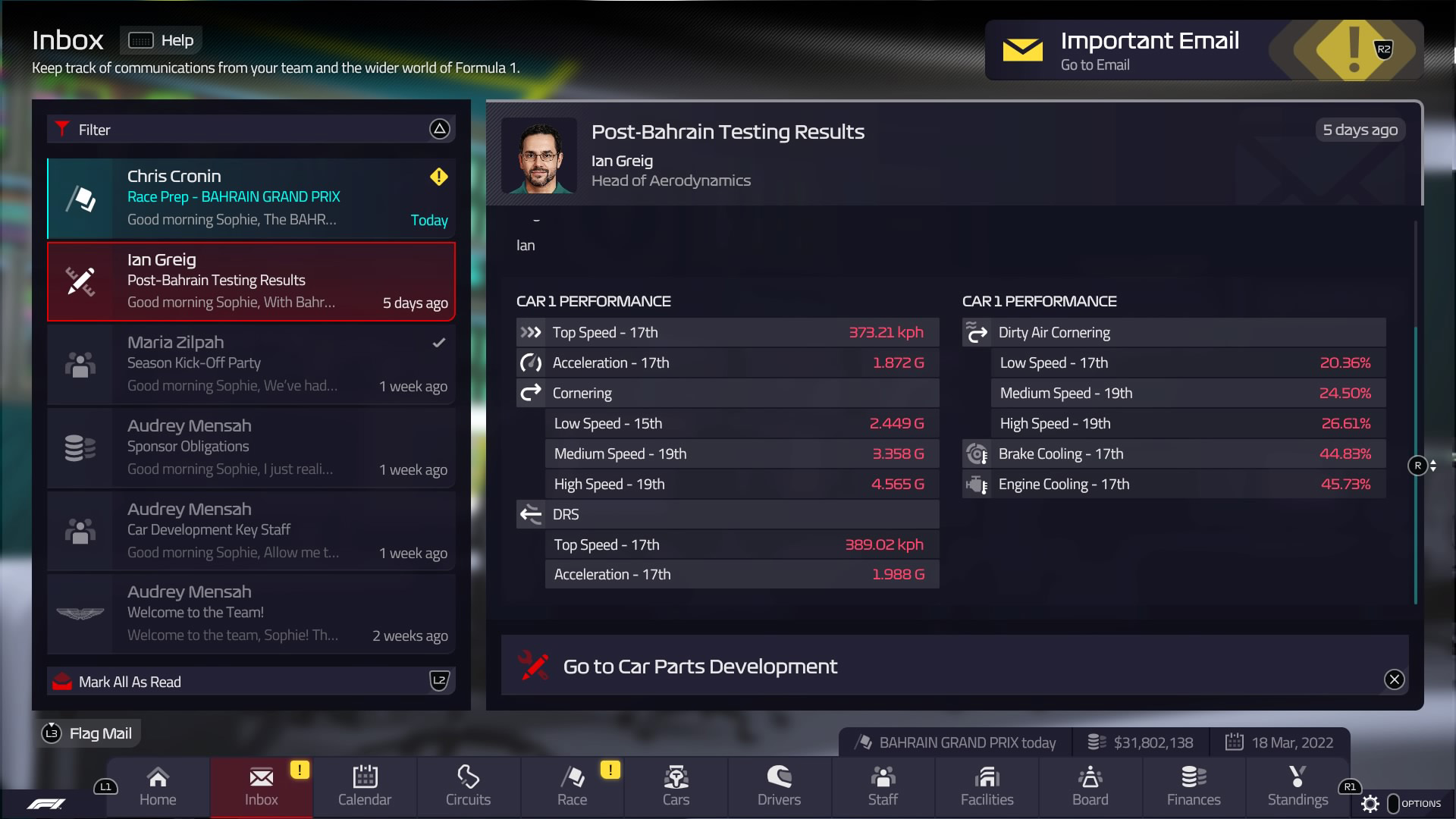
Me, I’ve been a fan of management simulation games since childhood, and I especially love Frontier’s other management sims like Planet Coaster and Jurassic World Evolution, so I was excited to give this one a try despite not being a huge F1 fan myself. F1 Manager 2022 takes those previous Frontier games—most notably the recent Jurassic World Evolution 2—and builds on them. Much of the interface was instantly familiar, just bigger and more detailed with more options and choices than ever before. Even as a management sim fangirl, however, this was a bit too much. Half of the individual screens could be games in themselves and the hours you would need to fully come to grips with everything here are more than many people would be willing to commit before walking away.
As for a final verdict, this will be a very hit-or-miss game that will either have players glued to their screens until dawn or throwing down their controllers before the end of the first Race Weekend. Which category you will fall into is something only you will know, but if you’ve ever watched an F1 team failing on the track and thought “I could do better than that!” then now’s your chance to prove it.
